APAC Cancer Therapies Market Size
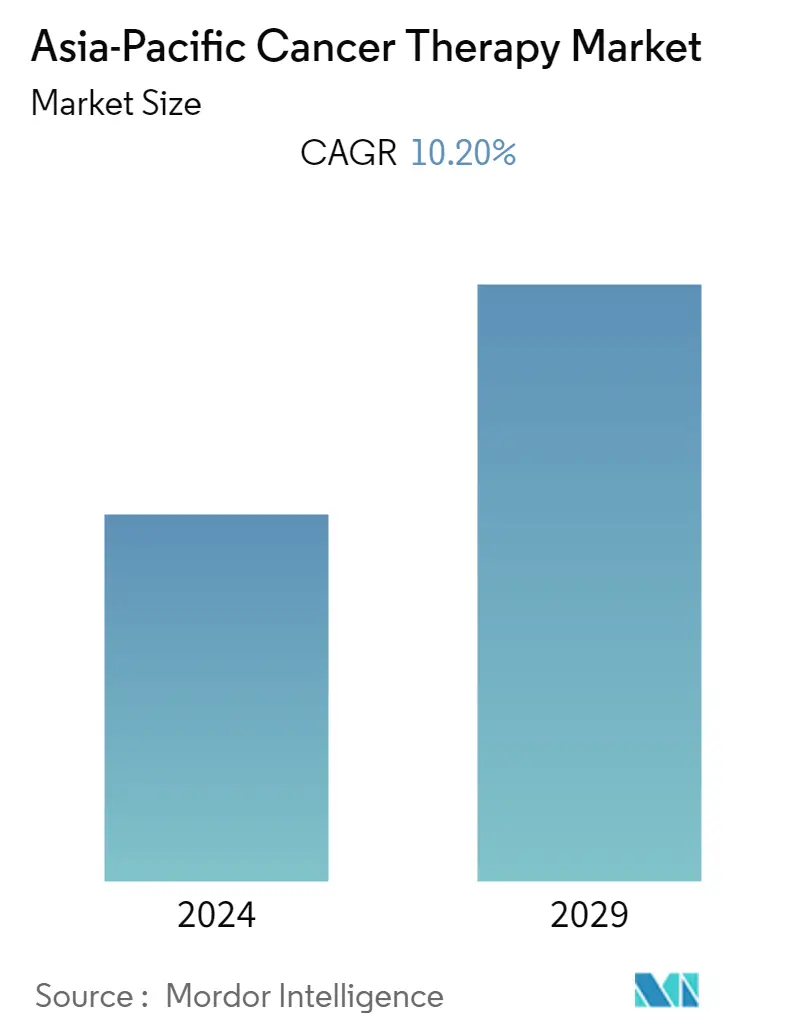
| Study Period | 2019 - 2029 |
| Base Year For Estimation | 2023 |
| Forecast Data Period | 2024 - 2029 |
| Historical Data Period | 2019 - 2022 |
| CAGR | 10.20 % |
Major Players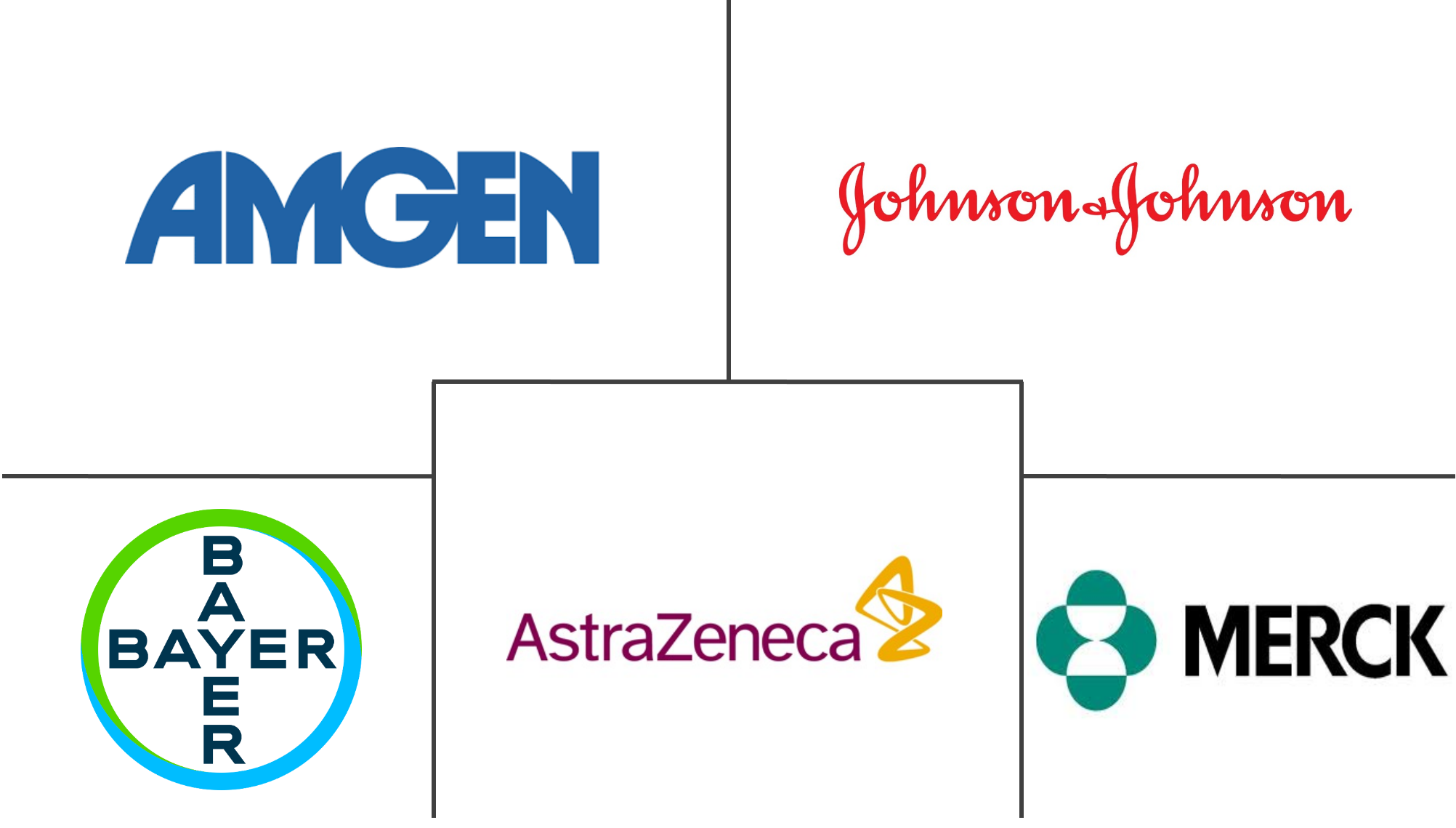
*Disclaimer: Major Players sorted in no particular order |
APAC Cancer Therapies Market Analysis
The Asia-Pacific cancer therapy market is expected to register a CAGR of 10.2% over the forecast period.
The COVID-19 pandemic disrupted routine care in many healthcare facilities and had an impact on healthcare systems all around the world, putting susceptible cancer patients in serious danger. The strict lockdowns and government regulations intended to slow down the spread of COVID-19 resulted in a decrease in therapy options for cancer patients. For instance, as per the study titled "Challenges and opportunities for ovarian cancer management in the epidemic of Covid-19: lessons learned from Wuhan, China" published in February 2021, treatment cancellation and delayed surgeries were challenging decisions. Ovarian cancer was identified as gynecologic cancer most affected by COVID-19, perhaps because of the frequent requirement for chemotherapy and ovarian debulking surgery. As a result, the pandemic might hurt the market. However, due to the rise in the incidence of cancers in the general population and fewer COVID-19 cases in the later stages of the pandemic, the market for treatments for cancer saw a noticeable increase in growth.
The Asia-Pacific cancer therapy market is expected to observe good growth owing to the rising prevalence of cancer, growing government initiatives for cancer awareness, and increasing patient assistance programs (PAPs). Lung, stomach, colorectum, liver, and esophagus are the most common types of cancer in Asia-Pacific region. For instance, as per the study titled "Burden of cancers in India - estimates of cancer crude incidence, YLLs, YLDs and DALYs for 2021 and 2025 based on National Cancer Registry Program" published in May 2022, the projected cancer burden in India for 2021 was 26.7 million Disability Adjusted Life Years (DALYs) and expected to increase to 29.8 million in 2025. Thus, the rising burden of cancers, helps the market to grow over the forecast period.
Furthermore, the advancements in the treatment of cancers with latest product approvals and launches drives the growth of the market. For instance, in August 2022, AstraZeneca India has received a Drugs Controller General of India (DCGI) approval to market its drug Lynparza (Olaparib) as a monotherapy for the adjuvant treatment of adult patients with BRCA-mutated HER2- negative high-risk early breast cancer. Therefore, owing to the aforementioned factors, the studied market is anticipated to witness growth over the analysis period.
However, the high cost of cancer therapies and fluctuation in reimbursement policies is likely to impede the market's growth.
APAC Cancer Therapies Market Trends
This section covers the major market trends shaping the APAC Cancer Therapies Market according to our research experts:
Target Therapy is Expected to Show the Significant Growth Over the Forecast Period
Targeted therapy is a type of cancer treatment that targets the changes in cancer cells that help them grow, divide, and spread. The targeted therapy includes gene expression modulators, apoptosis inducers, angiogenesis inhibitors, signal transduction inhibitors, and toxin delivery molecules. The drugs for target therapy work by targeting the specific genes or proteins that are present in the cancer cells. Targeted therapy is attaining importance due to its specificity toward cancer cells while sparing toxicity to off-target cells.
The major factors driving the growth of the segment are an increase in R&D and the rising prevalence and incidence of various types of cancer across the globe. For instance, as per the 2022 updated report of Janssen, Asia Pacific hosts 50% of the world's new cancer cases each year, and deaths caused by cancer in Asia are expected to increase by 36% by 2030. Also, Asia Pacific has the highest incidence of liver and stomach cancers, and prostate cancer is one of the leading male cancers in some Asian countries. Hence, increasing cancer will increase the demand for treatment options for cancers which will increase the market growth.
Furthermore, the new developments and approvals of the drugs under targeted therapy segment helps the market to grow. For instance, in August 2022, AstraZeneca's Tagrisso (osimertinib) has been approved in Japan for the adjuvant treatment of patients with epidermal growth factor receptor-mutated (EGFRm) non-small cell lung cancer (NSCLC) after surgery.
Thus the above-mentioned factors are expected to drive the growth of the targeted therapy segment during the forecast period.
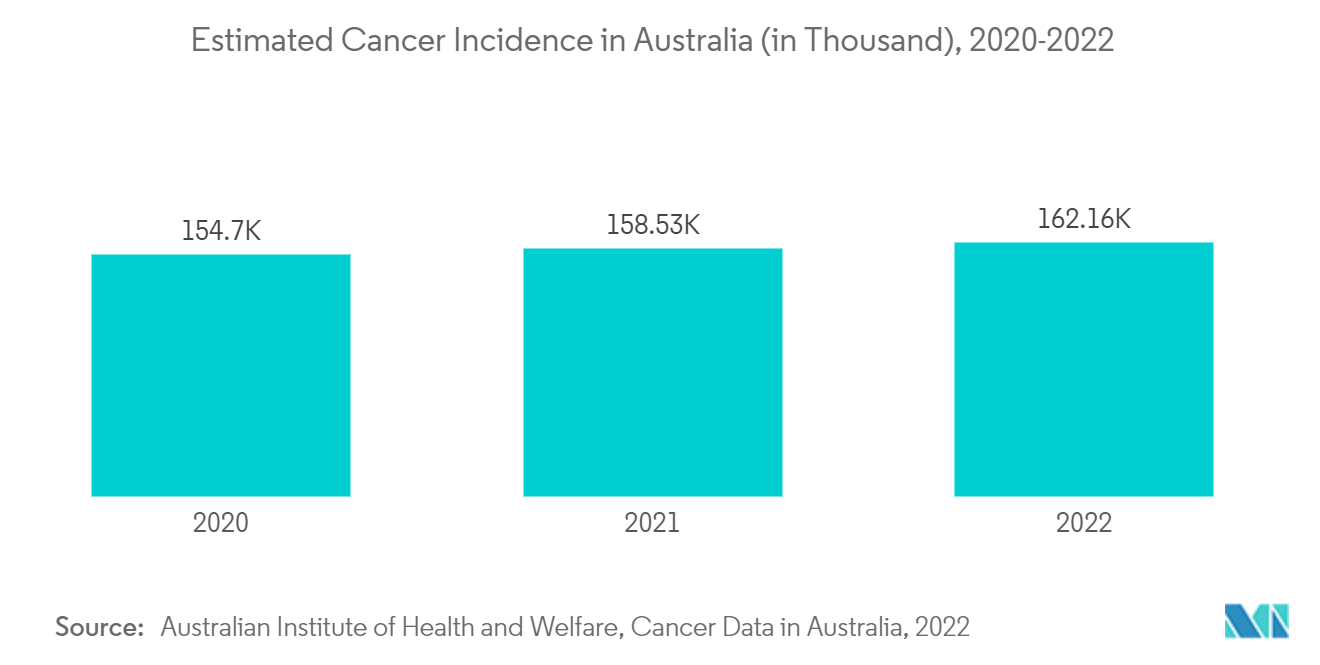
China is Expected to Dominate the Market Over the Forecast Period
The major factors fueling the market growth in China are the increasing burden of cancers, the growing focus on research and development of effective therapies for cancer, and the rising number of product approvals and launches along with increasing investment.
According to the report titled "Cancer statistics in China and United States, 2022: profiles, trends, and determinants" published in February 2022, compared to the 4,568,754 new cancer cases in China in 2020, the predicted number of new cancer cases for 2022 is 4,820,000. This increase in the new cases will directly increase the demand for cancer therapy, thus helping in the growth of the market during the study period. Also, as per the report titled "Changing profiles of cancer burden worldwide and in China: a secondary analysis of the global cancer statistics 2020" published in April 2021, China is expected to experience 6.85 million new cancer cases and 5.07 million deaths in 2040. Thus, the increase in the incidence of cancer cases in China will drive the market over the forecast period.
Furthermore, the new product approvals and launches for cancers will drive market growth. For instance, in June 2022, China National Medical Products Administration (NMPA) has approved BeiGene's anti-PD-1 antibody, tislelizumab, in combination with chemotherapy as a first-line treatment for patients with recurrent or metastatic nasopharyngeal cancer (NPC). Also, in July 2021, AstraZeneca's Imfinzi (durvalumab) has been approved in China for the 1st-line treatment of adult patients with extensive-stage small cell lung cancer (ES-SCLC), in combination with standard of care platinum chemotherapy (etoposide plus a choice of either carboplatin or cisplatin).
Thus, given the aforementioned factors, the cancer therapy market is expected to grow significantly over the forecast period in China.
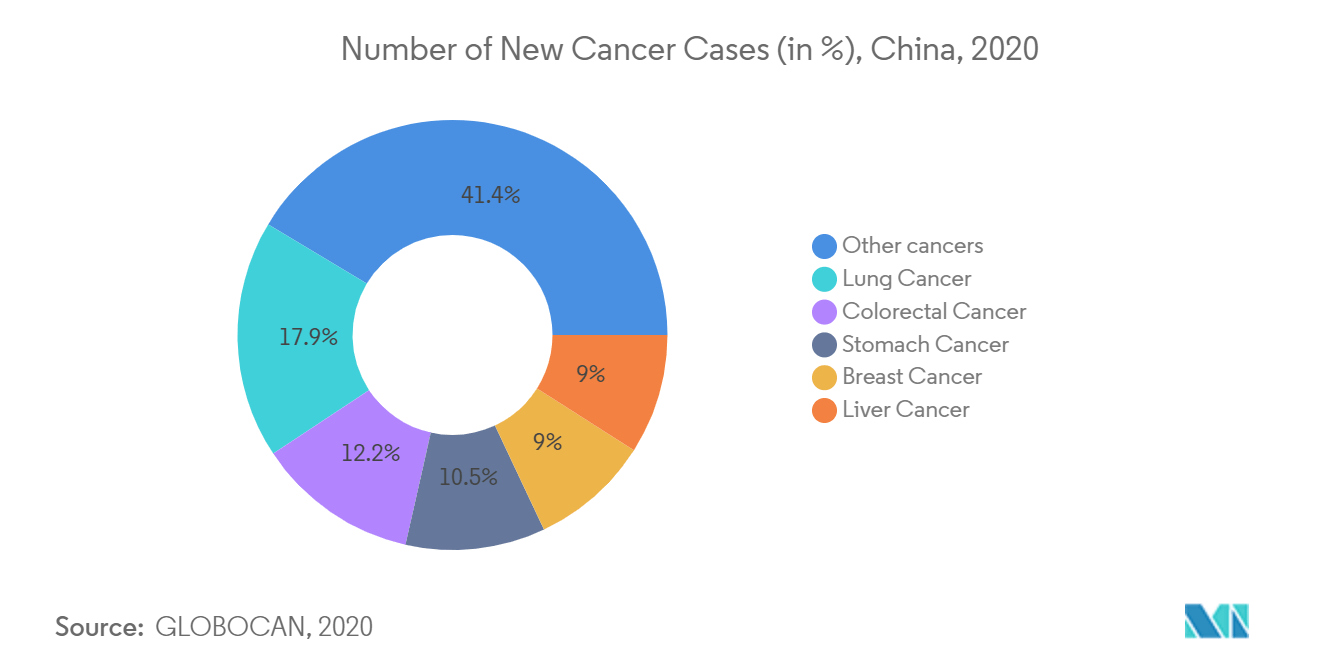
APAC Cancer Therapies Industry Overview
The cancer therapy market is highly competitive and consists of several players. In terms of market share, few of the major players currently dominate the market. However, with technological advancements and product innovations, mid-size to smaller companies are increasing their market presence, by introducing new products at cheaper prices. The major players include Amgen Inc, AstraZeneca, Bayer AG, Bristol-Myers Squibb Company, F. Hoffmann-La Roche Ltd, Johnson & Johnson Services, Inc., Merck & Co., Inc., Lilly, Novartis AG, and Pfizer Inc.
APAC Cancer Therapies Market Leaders
-
Merck & Co. Inc.
-
Bayer AG
-
Amgen Inc
-
AstraZeneca
-
Johnson & Johnson Services, Inc.
*Disclaimer: Major Players sorted in no particular order
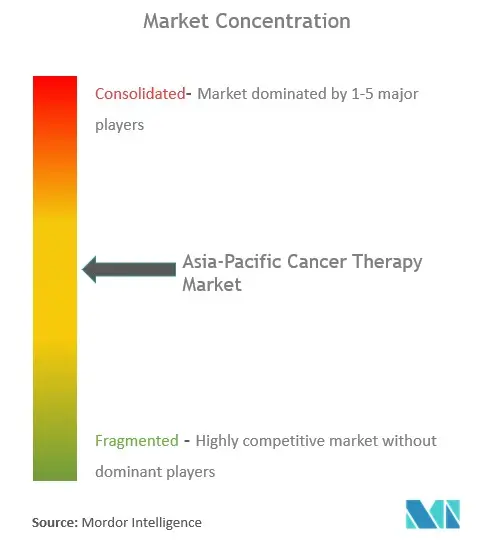
APAC Cancer Therapies Market News
- In May 2022, Roche Pharma launched PHESGO, the first ever fixed-dose formulation in oncology to combine two monoclonal antibodies, Perjeta (pertuzumab) and Herceptin (trastuzumab) with hyaluronidase, administered by subcutaneous injection in combination with intravenous (IV) chemotherapy, for the treatment of early and metastatic HER2-positive breast cancer in India.
- In February 2022, Ono Pharma Korea Co., Ltd. a South Korean subsidiary of ONO, received approvals for Opdivo (nivolumab) Intravenous Infusion ("Opdivo"), a human anti-human PD-1 monoclonal antibody, on February 14 from the Ministry of Food and Drug Safety (MFDS) in South Korea for two adjuvant treatments (esophageal or gastroesophageal junction cancer, muscle-invasive bladder carcinoma (MIBC)) and for three combination treatments for various cancers.
APAC Cancer Therapies Market Report - Table of Contents
1. INTRODUCTION
- 1.1 Study Assumptions and Market Definition
- 1.2 Scope of the Study
2. RESEARCH METHODOLOGY
3. EXECUTIVE SUMMARY
4. MARKET DYNAMICS
- 4.1 Market Overview
-
4.2 Market Drivers
- 4.2.1 Rising Prevalence of Cancer
- 4.2.2 Growing Government Initiatives for Cancer Awareness
- 4.2.3 Increasing Patient Assistance Programs (PAPs)
-
4.3 Market Restraints
- 4.3.1 High Cost of Cancer Therapies
- 4.3.2 Fluctuation in Reimbursement Policies
-
4.4 Porter's Five Force Analysis
- 4.4.1 Threat of New Entrants
- 4.4.2 Bargaining Power of Buyers/Consumers
- 4.4.3 Bargaining Power of Suppliers
- 4.4.4 Threat of Substitute Products
- 4.4.5 Intensity of Competitive Rivalry
5. MARKET SEGMENTATION (Market Size by Value - USD million)
-
5.1 By Treatment Type
- 5.1.1 Chemotherapy
- 5.1.2 Target Therapy
- 5.1.3 Immunotherapy
- 5.1.4 Hormone Therapy
- 5.1.5 Other Treatment Types
-
5.2 By Cancer Type
- 5.2.1 Blood Cancer
- 5.2.2 Breast Cancer
- 5.2.3 Prostate Cancer
- 5.2.4 Gastrointestinal Cancer
- 5.2.5 Gynecologic Cancer
- 5.2.6 Respiratory/Lung Cancer
- 5.2.7 Other Cancer Types
-
5.3 By End User
- 5.3.1 Hospitals
- 5.3.2 Specialty Clinics
- 5.3.3 Radiation Therapy Center
-
5.4 Geography
- 5.4.1 China
- 5.4.2 Japan
- 5.4.3 India
- 5.4.4 Australia
- 5.4.5 South Korea
- 5.4.6 Rest of Asia-Pacific
6. COMPETITIVE LANDSCAPE
-
6.1 Company Profiles
- 6.1.1 Amgen Inc
- 6.1.2 AstraZeneca
- 6.1.3 Bayer AG
- 6.1.4 Bristol Myers Squibb Company
- 6.1.5 F. Hoffman-La Roche Ltd
- 6.1.6 Johnson & Johnson Services, Inc.
- 6.1.7 Merck & Co. Inc.
- 6.1.8 Lilly
- 6.1.9 Novartis AG
- 6.1.10 Pfizer Inc.
- *List Not Exhaustive
7. MARKET OPPORTUNITIES AND FUTURE TRENDS
** Subject To AvailablityAPAC Cancer Therapies Industry Segmentation
As per the scope of the report, cancer therapies are drugs that block the growth and proliferation of cancer, by interfering with specific molecules, such as DNA or proteins, which are involved in the growth or expansion of cancerous cells. These therapies include surgery, radiation therapy, chemotherapy, immunotherapy, etc. The Asia-Pacific cancer therapy market is segmented by treatment type (chemotherapy, target therapy, immunotherapy, hormone therapy, and other treatment types), cancer type (blood cancer, breast cancer, prostate cancer, gastrointestinal cancer, gynecologic cancer, respiratory/lung cancer, and other cancer types), end user (hospitals, specialty clinics, radiation therapy center) and geography (China, Japan, India, Australia, South Korea and Rest of Asia-Pacific). The report offers the value (in USD million) for the above segments.
| By Treatment Type | Chemotherapy |
| Target Therapy | |
| Immunotherapy | |
| Hormone Therapy | |
| Other Treatment Types | |
| By Cancer Type | Blood Cancer |
| Breast Cancer | |
| Prostate Cancer | |
| Gastrointestinal Cancer | |
| Gynecologic Cancer | |
| Respiratory/Lung Cancer | |
| Other Cancer Types | |
| By End User | Hospitals |
| Specialty Clinics | |
| Radiation Therapy Center | |
| Geography | China |
| Japan | |
| India | |
| Australia | |
| South Korea | |
| Rest of Asia-Pacific |
APAC Cancer Therapies Market Research FAQs
What is the current Asia-Pacific Cancer Therapy Market size?
The Asia-Pacific Cancer Therapy Market is projected to register a CAGR of 10.20% during the forecast period (2024-2029)
Who are the key players in Asia-Pacific Cancer Therapy Market?
Merck & Co. Inc., Bayer AG, Amgen Inc, AstraZeneca and Johnson & Johnson Services, Inc. are the major companies operating in the Asia-Pacific Cancer Therapy Market.
What years does this Asia-Pacific Cancer Therapy Market cover?
The report covers the Asia-Pacific Cancer Therapy Market historical market size for years: 2019, 2020, 2021, 2022 and 2023. The report also forecasts the Asia-Pacific Cancer Therapy Market size for years: 2024, 2025, 2026, 2027, 2028 and 2029.
Asia-Pacific Cancer Therapy Industry Report
Statistics for the 2024 Asia-Pacific Cancer Therapy market share, size and revenue growth rate, created by Mordor Intelligence™ Industry Reports. Asia-Pacific Cancer Therapy analysis includes a market forecast outlook to 2029 and historical overview. Get a sample of this industry analysis as a free report PDF download.



